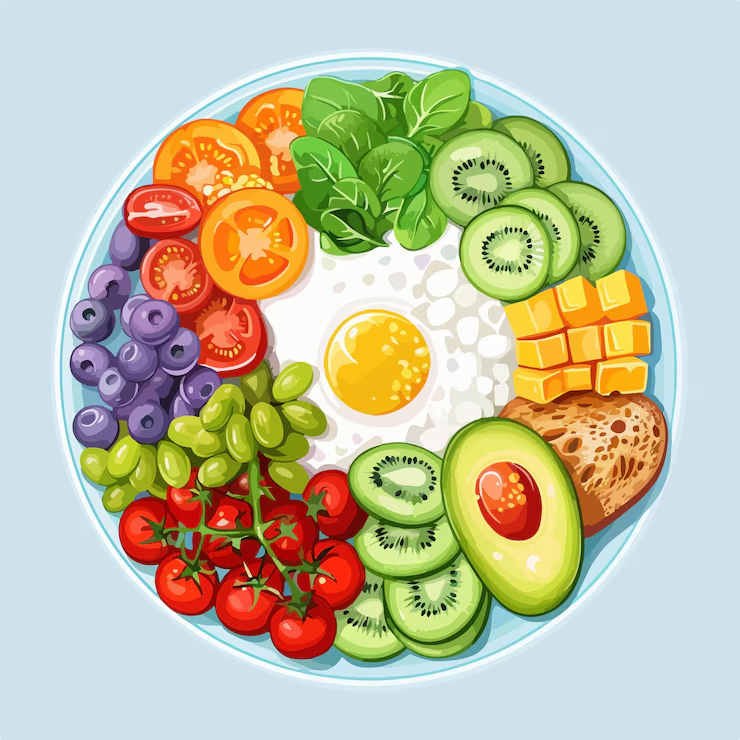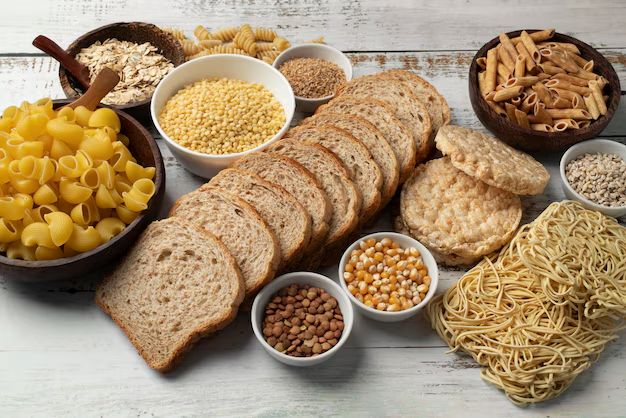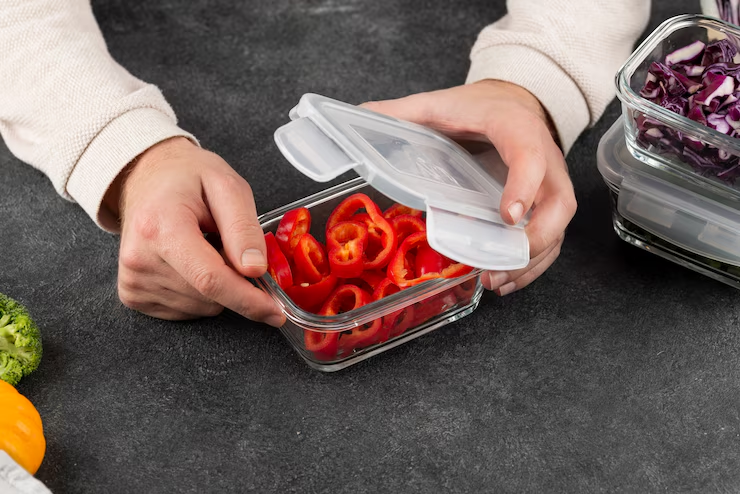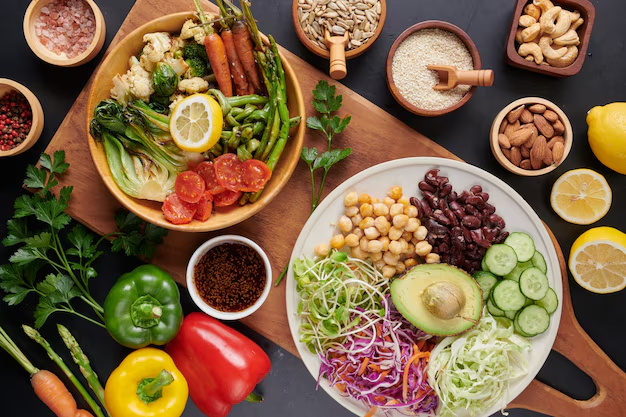Eating healthy is one of the key foundations for maintaining long-term health and well-being. In today’s world of convenience foods, fast food chains, and sugar-loaded beverages, making smart dietary choices is more important than ever. Choosing healthy meals ensures your body receives the nutrients it needs to function properly and prevent illness.
A well-planned healthy meal includes a balance of lean proteins, whole grains, healthy fats, and plenty of fruits and vegetables. These meals not only support weight management but also improve energy levels, enhance digestion, and reduce the risk of chronic conditions like heart disease and diabetes. The focus should be on whole, minimally processed foods that are rich in vitamins and minerals.
In this article, we’ll explore what makes healthy meals truly nutritious, how to plan and portion your food effectively, and why these habits are crucial for lifelong wellness. Small, consistent changes in your eating habits can lead to significant long-term benefits.

What is a Healthy Meal ?
A healthy meal is one that provides a well-balanced combination of nutrients your body needs to function optimally. It typically includes a mix of macronutrients—carbohydrates, proteins, and fats—alongside a wide range of vitamins and minerals. The goal of healthy meals is to nourish the body, fuel energy levels, and support long-term health.
One of the key components of healthy meals is the inclusion of whole, unprocessed foods. This means plenty of vegetables, fruits, whole grains, lean proteins like fish or legumes, and healthy fats such as nuts, seeds, or olive oil. These ingredients are rich in fiber, antioxidants, and essential nutrients that promote overall well-being.
Portion control is equally important. Even nutritious foods can lead to weight gain or imbalance if eaten in excess. By being mindful of serving sizes and listening to your body’s hunger cues, you can maintain a healthy relationship with food.
Incorporating healthy meals into your daily routine doesn’t have to be complicated. With simple planning and smart choices, you can enjoy delicious, satisfying meals that support your body and mind every day.
Before diving into the tips and strategies, it’s important to define what constitutes a healthy meal. In general, a healthy meal:
Contains a variety of foods: A healthy meal should include foods from all the major food groups: vegetables, fruits, whole grains, protein sources (such as lean meats, beans, or tofu), and healthy fats (like nuts, seeds, and olive oil).
Is balanced: A healthy meal should have the right balance of macronutrients (carbohydrates, proteins, and fats) to support your body’s needs.
Is nutrient-dense: Healthy meals are rich in vitamins, minerals, fiber, and antioxidants, which are vital for overall health.
Portion-controlled: Eating the right amount of food for your energy needs is key to maintaining a healthy weight.
Top Tips for Building Healthy Meals
Incorporate a Variety of Vegetables
Vegetables are a vital part of healthy meals, offering a wide range of nutrients with very few calories. They are rich in vitamins, minerals, and antioxidants that support your immune system, boost skin health, and help protect against chronic diseases. Including more vegetables in your diet is one of the simplest ways to improve your overall nutrition.

For truly healthy meals, aim to fill at least half your plate with vegetables at every meal. Leafy greens, carrots, bell peppers, broccoli, and zucchini are all excellent choices. The variety not only adds flavor and color to your plate but also ensures you’re getting different nutrients that your body needs for optimal function.
Vegetables are also high in fiber, which plays a key role in digestion and helps you feel full longer. This makes them perfect for weight management and portion control. Incorporating a variety of vegetables into your daily routine can significantly elevate the quality of your healthy meals.
Benefits:
Rich in Nutrients: Vegetables are low in calories but packed with essential nutrients like fiber, vitamins (A, C, K), and minerals (potassium, magnesium), which are vital for overall health.
Antioxidants: Vegetables, especially colorful ones, are high in antioxidants that help fight inflammation and reduce the risk of chronic diseases, including heart disease and cancer.
Fiber for Digestion: The fiber content in vegetables aids in digestion, helps regulate bowel movements, and contributes to a healthy gut microbiome.
Key Ingredients:
Leafy Greens: Spinach, kale, collard greens, Swiss chard.
Cruciferous Vegetables: Broccoli, cauliflower, Brussels sprouts, cabbage.
Root Vegetables: Carrots, sweet potatoes, beets, parsnips.
Other Colorful Veggies: Bell peppers, tomatoes, zucchini, eggplant, cucumbers.
Tip for success: Include vegetables from different color groups in each meal (e.g., red peppers, spinach, carrots, and purple cabbage) to ensure a wide range of nutrients.
Prioritize Lean Protein Sources
Prioritizing lean protein sources is essential for building healthy meals that support muscle repair, immune function, and overall energy. Protein also helps you feel full for longer periods, making it easier to manage your appetite and avoid unhealthy snacking throughout the day.
Great lean protein options include chicken breast, turkey, fish, tofu, eggs, legumes, and low-fat dairy. These foods provide high-quality protein without excessive saturated fat or calories, making them perfect for balanced and healthy meals. Plant-based proteins like lentils, beans, and quinoa are also rich in fiber and ideal for vegetarian or vegan diets.
Including lean protein in every meal helps stabilize blood sugar levels, supports weight management, and promotes long-lasting satiety. Whether you’re preparing a salad, stir-fry, or grain bowl, incorporating a lean protein source is a simple and effective way to make your healthy meals more nutritious and satisfying. Aim for variety to keep your diet interesting and well-rounded.
Benefits:
Muscle Repair and Growth: Protein plays a crucial role in repairing muscles, tissues, and maintaining a healthy immune system.
Satiety and Weight Management: Protein-rich foods are satisfying and help you feel full longer, preventing overeating and supporting weight management.
Supports Metabolism: Protein has a higher thermic effect than carbohydrates or fats, meaning your body burns more calories digesting protein.
Key Ingredients:
Poultry: Skinless chicken breast, turkey.
Fish: Salmon, tuna, mackerel, cod, and other lean fish.
Legumes: Lentils, chickpeas, black beans, kidney beans.
Plant-based Options: Tofu, tempeh, edamame.
Low-fat Dairy: Greek yogurt, cottage cheese.
Tip for success: Aim to include at least one protein source in each meal (e.g., grilled chicken with a salad, lentils with quinoa, or salmon with roasted veggies).
Include Whole Grains
Including whole grains in your diet is a key step toward building truly healthy meals. Whole grains like brown rice, quinoa, oats, barley, and whole wheat bread are rich in fiber, B vitamins, and essential minerals such as iron and magnesium. Unlike refined grains, they retain the bran and germ, making them more nutritious and beneficial for your health.

Whole grains play a major role in supporting digestion, stabilizing blood sugar levels, and keeping you full for longer. This makes them an excellent choice for weight management and sustained energy. Adding whole grains to your healthy meals helps improve heart health and lowers the risk of chronic diseases such as type 2 diabetes and certain cancers.
Incorporating whole grains can be as simple as swapping white rice for brown rice or choosing whole grain bread over white. When planning your healthy meals, aim to make whole grains a regular part of your plate for lasting health benefits.
Benefits:
Stabilizes Blood Sugar: Whole grains have a lower glycemic index compared to refined grains, meaning they have a slower effect on blood sugar levels, helping to manage insulin sensitivity.
Rich in Fiber: The fiber in whole grains helps control cholesterol levels, promotes healthy digestion, and keeps you feeling fuller for longer.
Reduces Chronic Disease Risk: Regular consumption of whole grains is associated with a lower risk of heart disease, diabetes, and stroke.
Key Ingredients:
Whole Grains: Brown rice, quinoa, barley, oats, farro, whole wheat.
Whole Wheat Products: Whole wheat bread, pasta, and wraps.
Pseudograins: Quinoa, amaranth, buckwheat.
Tip for success: Substitute white rice with brown rice or quinoa, and try whole wheat pasta or oatmeal in place of refined options for added fiber and nutrients.
Use Healthy Fats
Using healthy fats is an important part of creating well-balanced and healthy meals. Unlike trans fats or excessive saturated fats, healthy fats support brain function, hormone production, and the absorption of fat-soluble vitamins like A, D, E, and K. They also help keep you full and satisfied, which is beneficial for weight management.
Sources of healthy fats include avocados, nuts, seeds, olive oil, and fatty fish like salmon and mackerel. Including these in your healthy meals not only adds flavor and texture but also boosts their nutritional value. Just be mindful of portion sizes, as fats are calorie-dense—even the healthy ones.
Incorporating healthy fats can be simple: drizzle olive oil over salads, add avocado to sandwiches, or sprinkle chia or flax seeds on your smoothie or oatmeal. When used in moderation, healthy fats enhance both the taste and benefits of your healthy meals, supporting long-term health and well-being.
Benefits:
Supports Brain Health: Healthy fats like omega-3 fatty acids are crucial for cognitive function and can reduce the risk of neurodegenerative diseases.
Absorption of Nutrients: Fat helps in the absorption of fat-soluble vitamins (A, D, E, K), which are essential for maintaining bone health, skin health, and immune function.
Reduces Inflammation: Healthy fats have anti-inflammatory properties that can help lower the risk of conditions like arthritis, heart disease, and even some cancers.
Key Ingredients:
Healthy Oils: Olive oil, avocado oil, coconut oil, flaxseed oil.
Nuts and Seeds: Almonds, walnuts, chia seeds, flaxseeds, sunflower seeds.
Fatty Fish: Salmon, mackerel, sardines.
Other Sources: Avocados, nut butters (like almond or peanut butter), dark chocolate.
Tip for success: Use olive oil to dress salads or cook vegetables, and snack on a handful of almonds or walnuts instead of chips or cookies.
Control Your Portions
Controlling your portions is a key element in maintaining balanced and healthy meals. Even when you’re eating nutritious foods, consuming them in large quantities can lead to excess calorie intake and weight gain. Understanding the difference between serving size and portion size can help you avoid overeating and better manage your daily intake.

A good strategy for portion control is to fill half your plate with vegetables, one-quarter with lean protein, and one-quarter with whole grains. This visual approach ensures you’re getting a balanced mix of nutrients in your healthy meals without going overboard. Using smaller plates and bowls can also help you naturally reduce portions without feeling deprived.
Listening to your body’s hunger and fullness cues is another effective way to manage portion sizes. By eating slowly and mindfully, you’re more likely to stop when you’re truly satisfied. Portion control, paired with nutrient-rich foods, makes your healthy meals both satisfying and supportive of your wellness goals.
Benefits:
Prevents Overeating: Portion control helps prevent excess calorie intake, promoting weight loss or maintenance and reducing the risk of obesity-related diseases.
Balanced Nutrient Intake: Controlling portions ensures that you’re getting the right balance of macronutrients (carbs, fats, proteins) without excess of any one, especially carbs or fats.
Improves Digestion: Eating the right amount of food at the right time helps prevent digestive issues like bloating or indigestion.
Key Ingredients:
Whole Foods: Vegetables, fruits, lean protein, whole grains, and healthy fats.
Measuring Tools: Food scales, measuring cups, or using your hand as a guide for portions (palm for protein, fist for carbs).
Tip for success: Use smaller plates, listen to your hunger cues, and avoid eating straight from packages. Taking time to eat slowly can also help you recognize when you’re full.
Eat a Variety of Fruits
Eating a variety of fruits is essential for creating nutrient-rich and healthy meals. Fruits are naturally packed with essential vitamins, minerals, antioxidants, and fiber, all of which support immune function, digestion, and overall health. Their natural sweetness also makes them a great substitute for sugary snacks and desserts.
Incorporating different colored fruits—such as berries, oranges, apples, bananas, and kiwi—ensures a wide range of nutrients. Each color often represents a different set of beneficial compounds. For example, berries are rich in antioxidants, while citrus fruits provide a strong dose of vitamin C. Adding fruits to your healthy meals boosts flavor and nutritional value without adding empty calories.
You can enjoy fruits fresh, frozen, or dried (in moderation) as part of your daily routine. Add them to smoothies, salads, oatmeal, or yogurt to enhance your meals. Aiming for at least 2 servings of fruit daily can make your healthy meals more balanced and satisfying.
Benefits:
Rich in Vitamins and Antioxidants: Fruits are a rich source of vitamins (especially vitamin C) and antioxidants, which help boost immunity, protect against oxidative stress, and reduce inflammation.
Promotes Digestive Health: The fiber in fruits helps regulate bowel movements, prevent constipation, and maintain a healthy digestive system.
Supports Weight Management: Low in calories but high in nutrients, fruits provide a sweet alternative to processed snacks, satisfying your cravings without compromising your health.
Key Ingredients:
Citrus Fruits: Oranges, grapefruits, lemons, limes.
Berries: Blueberries, strawberries, raspberries, blackberries.
Tropical Fruits: Mango, pineapple, papaya, kiwi.
Other Fruits: Apples, pears, bananas, grapes, pomegranates, watermelon.
Tip for success: Incorporate fruits into every meal—add berries to oatmeal, have an apple with your lunch, or snack on some tropical fruit like mango or pineapple in between meals.
Stay Hydrated
Staying hydrated is a crucial part of maintaining overall health and enhancing the benefits of your healthy meals. Water supports nearly every function in the body—from regulating temperature and aiding digestion to transporting nutrients and removing waste. Without enough hydration, your body can’t absorb the nutrients from food effectively.
Dehydration can lead to fatigue, headaches, poor concentration, and even overeating, as thirst is often mistaken for hunger. Drinking water before, during, and after your healthy meals can help with digestion and promote a feeling of fullness, preventing unnecessary snacking or overeating.
Aim to drink at least 8 cups (about 2 liters) of water daily, though your needs may vary depending on activity level and climate. You can also increase hydration by consuming water-rich foods like cucumbers, watermelon, and oranges. Staying hydrated not only boosts energy but also helps your body get the most out of your healthy meals every day.
Benefits:
Boosts Energy Levels: Staying hydrated ensures optimal circulation and nutrient delivery throughout the body, helping you feel more energized and focused.
Supports Digestion: Drinking enough water helps in breaking down food, allowing your body to absorb nutrients efficiently.
Improves Skin Health: Adequate hydration keeps your skin hydrated, improving its elasticity and appearance while preventing dryness and wrinkles.
Key Ingredients:
Water: Plain water, sparkling water.
Infused Water: Lemon, cucumber, mint, or berries added to water for extra flavor.
Herbal Teas: Green tea, chamomile, peppermint.
Tip for success: Carry a water bottle with you at all times, and aim to drink at least 8 glasses of water a day. Try herbal teas for variety and flavor without added sugar.
Plan and Prepare Your Meals Ahead of Time
Planning and preparing your meals ahead of time is a powerful strategy for maintaining consistent and nutritious healthy meals throughout the week. Meal prepping helps you avoid impulsive food choices, reduces reliance on processed or fast foods, and ensures you always have balanced options readily available.
By setting aside time to plan your weekly menu, create a grocery list, and prepare ingredients in advance, you can save time and reduce stress during busy weekdays. Prepping elements like cooked grains, chopped veggies, and pre-portioned proteins makes assembling healthy meals quick and convenient, even on your busiest days.
Meal planning also gives you more control over portion sizes and nutritional balance, ensuring that your meals contain the right mix of protein, fiber, healthy fats, and whole grains. With just a little preparation, you can stay on track with your health goals and enjoy delicious, home-cooked healthy meals every day.
Benefits:
Consistency in Healthy Eating: Meal prepping ensures that you’re always prepared with healthy, portion-controlled meals, reducing the temptation to eat unhealthy options when you’re hungry or busy.
Saves Time and Money: Preparing meals in advance can save you both time and money, reducing the need for takeout or expensive pre-packaged foods.
Helps Maintain Balance: By planning ahead, you can ensure that each meal includes a good balance of vegetables, proteins, grains, and healthy fats.
Key Ingredients:
Prepared Vegetables: Pre-chopped veggies for stir-fries, salads, or roasting.
Cooked Proteins: Grilled chicken breast, roasted tofu, boiled eggs.
Grains: Cooked quinoa, brown rice, or whole wheat pasta.
Storage Containers: Meal prep containers for portioning and storing meals.
Tip for success: Set aside time on Sundays (or any day that works for you) to cook and prepare meals for the week. Store them in portioned containers so you can easily grab a healthy meal on the go.
Why Portion Control is Key
Understanding Portion Sizes
Portion control is a fundamental aspect of healthy eating. In today’s society, portions have grown exponentially, especially at restaurants and fast food establishments. What many people don’t realize is that portion sizes often exceed the actual nutritional needs of an individual.
The key to maintaining a healthy weight and supporting your overall health lies in eating the right amount of food. Overeating, even healthy foods, can lead to an excess of calories, which might eventually result in weight gain or other health issues.
How to implement portion control:
Use smaller plates and bowls: This simple strategy can help you eat less without feeling deprived.
Read food labels: Pay attention to the serving size and caloric content to help you make informed decisions.
Follow the “hand rule”: For protein, a portion is about the size of your palm; for carbs (like rice or pasta), it should fit in the cupped palm of your hand.
Measure your food: Especially when starting, use measuring cups or a food scale to familiarize yourself with proper portion sizes.
Why It’s Important to Maintain Portion Control
Prevents overeating: By controlling portions, you can prevent the temptation to eat more than necessary.
Promotes balanced nutrition: A well-portioned meal ensures that you are getting the right balance of macronutrients (protein, fat, carbs).
Supports weight management: Consistently practicing portion control helps you manage your calorie intake, which is essential for both weight loss and weight maintenance.
Conclusion

Healthy meals are a key part of a balanced lifestyle, helping you improve your overall health, boost energy levels, and enhance well-being. By following a few simple strategies—like eating a variety of vegetables, choosing lean proteins, and including whole grains—you can build meals that are both nourishing and satisfying.
Incorporating healthy fats, staying hydrated, controlling portion sizes, and planning your meals in advance further strengthens your commitment to eating well. These habits make it easier to prepare healthy meals that support weight management, digestion, and long-term wellness, all while keeping your taste buds happy.
Eating healthy doesn’t mean giving up flavor or enjoyment. With creativity, smart choices, and mindful preparation, you can enjoy healthy meals every day without feeling restricted. Start by adopting one or two of these tips and gradually build a routine that suits your lifestyle. Small, consistent changes can lead to lasting benefits for your body and mind.
FAQs
Q1. What are healthy meals ?
Healthy meals are well-balanced dishes that provide essential nutrients like protein, fiber, healthy fats, vitamins, and minerals. They include whole foods such as vegetables, fruits, whole grains, lean proteins, and healthy fats, while minimizing processed ingredients, added sugars, and excess sodium. The goal is to nourish your body, support energy levels, and promote long-term wellness.
Q2. How can I make my meals healthier without sacrificing taste ?
You can make healthy meals tasty by using fresh herbs, spices, and natural flavor enhancers like lemon juice, garlic, or ginger. Opt for grilling, baking, or steaming instead of frying. Swap unhealthy ingredients for nutritious alternatives—like using Greek yogurt instead of sour cream, or whole grain pasta instead of refined versions.
Q3. Are healthy meals expensive to prepare?
Not necessarily. Healthy meals can be budget-friendly when you buy seasonal produce, plan ahead, and cook in bulk. Whole grains, legumes, and frozen vegetables are cost-effective and nutritious. Meal planning also helps reduce food waste and unnecessary grocery spending.
Q4. How often should I eat healthy meals ?
Ideally, every meal should aim to be balanced and nourishing. Consistently choosing healthy meals for breakfast, lunch, and dinner supports better digestion, stable energy, and weight control. It’s okay to enjoy occasional treats, but making nutritious meals your daily habit is key to overall health.
Q5. Can healthy meals help with weight loss ?
Yes, healthy meals that are rich in fiber, lean protein, and whole foods can promote satiety and reduce cravings. This helps you manage calorie intake without feeling deprived. Portion control and mindful eating also play a big role in using healthy meals effectively for weight management.


